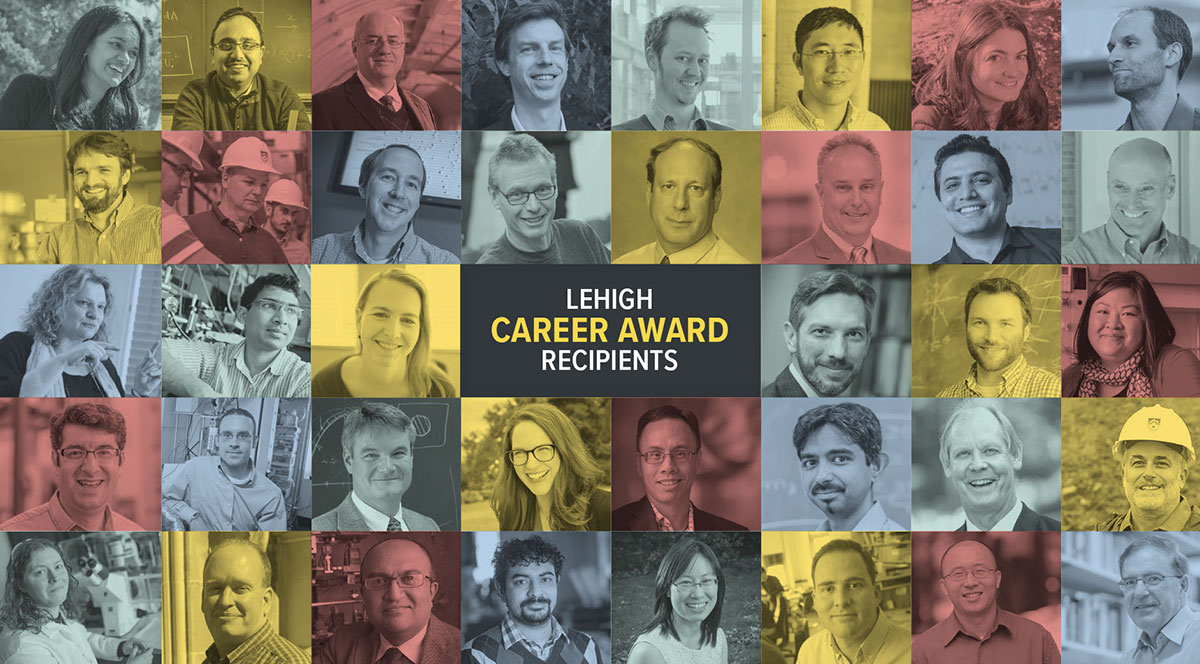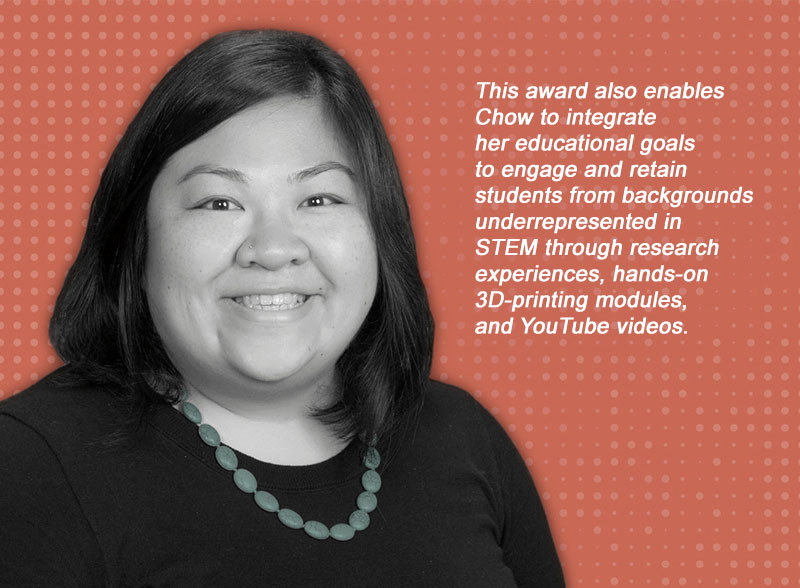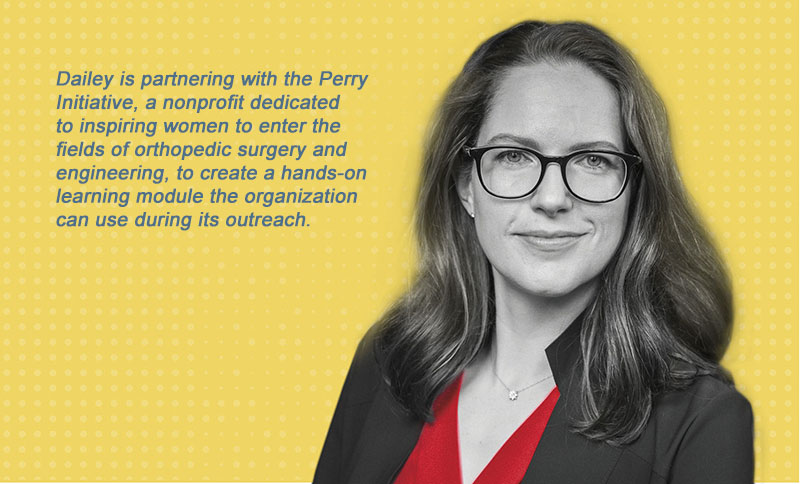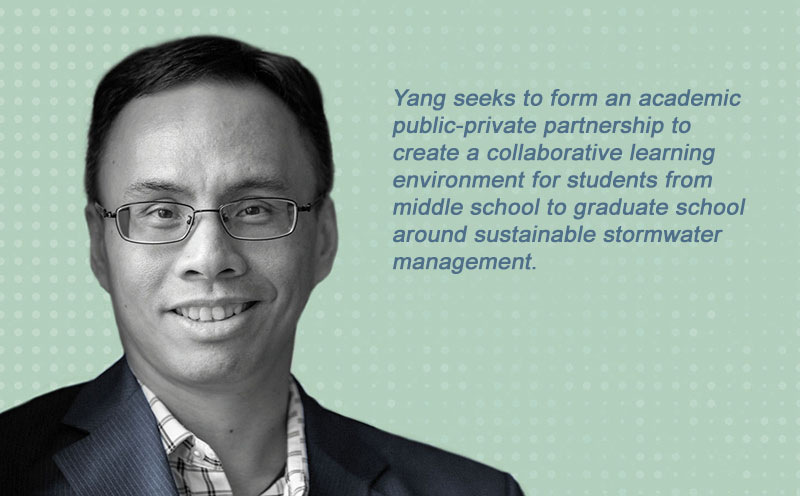

By Christine Fennessy Across higher education, recognition from the National Science Foundation’s Faculty Early Career Development Program is seen as validation that a newer science/engineering faculty member is growing into an academic powerhouse. NSF CAREER grants support junior faculty members who exemplify the role of teacher-scholar through outstanding research, top-notch educational instruction, and the integration of the two pursuits. Each award provides stable support of approximately $500,000 over a five-year period. In the Rossin College, 30 percent of active faculty have earned the NSF CAREER award since its inception. And since 2015, an astounding 16 of the college’s professors—more than 75 percent of eligible new faculty over this period—have secured this prestigious funding. Collectively, these accomplishments tell a powerful, interdisciplinary story about a scholarly community on the rise. One that identifies, nurtures, and celebrates research and educational innovators who are developing into the future leaders of their respective fields. The next chapter of that story begins here... |
 Lesley Chow: A better way to rebuild cartilage
Lesley Chow: A better way to rebuild cartilage
If you’re able to walk without pain, give a silent shout-out to your cartilage.
Every time you take a step, this flexible tissue absorbs the load and transfers it to the bone, allowing you to move freely. But unlike bone, if cartilage gets damaged—by injury, wear and tear, or inflammation—it can’t regenerate. Over time, the damaged tissue degrades, and walking becomes progressively more painful.
“Eventually, you’ll develop osteoarthritis, which affects about 32 million Americans,” says Lesley Chow, Frank Hook Assistant Professor of Bioengineering and Materials Science and Engineering. “And while there are some surgical interventions, you eventually hit a point where you’re in so much pain and have such a loss of mobility that you need a total knee replacement.”
Effective interventions for osteoarthritis don’t yet exist because cartilage is so difficult to regenerate.
But if a biomaterial could be developed that successfully directed regeneration of the entire osteo-chondral (“osteo” for bone, “chondral” for cartilage) tissue, says Chow, cartilage injuries could be treated earlier and degeneration could be slowed or halted altogether.
“If we can intervene when you first have that injury, this therapy has potential to buy you 10 or more years—or maybe you would never need a knee replacement,” she says. “That’s the dream.”
It’s a dream that’s now a step closer: Chow’s CAREER award will support her lab’s work in refining their 3D-printed biomaterial to provide exact signals to cells to form tissues organized in the same way as native osteochondral tissue.
“We know that our bodies have cells that are capable of regrowing these tissues, but what if we aren’t giving them the right chemical and physical cues?” says Chow. “We would like to be able to change the chemistry of our biomaterial without changing the physical properties. This is very difficult because these properties are inherently tied to each other, but my lab has developed a platform where we can change these cues independently.”
The team’s 3D-printed scaffolds have yielded promising results. Prior to printing, peptides (short segments of proteins) are synthesized with sequences designed to promote bone or cartilage formation. The researchers attach these peptides to biodegradable polymers and 3D print the resulting peptide-polymer conjugates to fabricate a peptide-functionalized material.
“It’s like a color printer,” says Chow. “Say you want to print your bone-promoting scaffold first and then transition to one that promotes cartilage. You just switch the ink in your printer. So within the same print, you end up with both bone- and cartilage-promoting peptides in one continuous biomaterial.”
With a better understanding of how cells respond to specific chemical and physical signals, the team hopes to fine-tune an “optimal material” that drives formation of the entire osteochondral tissue. Chow’s ultimate goal, however, is twofold: a biodegradable implant and a fundamental tool set that can be translated to other tissues like tendon, ligament, and skin.
“We want this platform to be an enabling technology for other groups—researchers who want to better understand the properties they need to develop in their own materials to regenerate other tissues of interest.”
 Hannah Dailey: An inside look at bone healing
Hannah Dailey: An inside look at bone healing
Broken bones have a unique capacity to heal. The new bone that forms along the fracture line, called callus, starts out as a soft tissue and, over time, it hardens into bone that is just as strong—or stronger—than before the break.
But in some cases, the healing process goes awry. This failure to heal is called a nonunion, a painful and often debilitating condition that requires further medical intervention.
“We know that nonunions happen in about 10 percent of fractures of the shinbone, and it’s impossible to predict who will have one,” says Hannah Dailey, an assistant professor of mechanical engineering and mechanics. “But patients who get a diagnosis of a nonunion can have higher rates of depression, opioid use, and addiction. They might be unable to return to work. So we want to be able to identify very early on when healing is not progressing well so surgeons can intervene sooner. The problem is that right now, you can’t make that early determination."
Dailey’s CAREER award will support the further development of a virtual mechanical test that will make such a determination possible. This project will help to define the mechanical properties of new bone tissue as well as the overall structural behavior of healing bones.
Using specialized software on low-dose computed tomography (CT) scans of patients who have sustained tibial fractures, Dailey and her team build 3D mechanical structural models that identify regions of bone and callus. They run the models through finite element analysis software that divides the bone model into tiny zones that all have a mathematical relationship to each other. They then simulate different types of loads that mimic the conditions during healing. The technique is called virtual mechanical testing. The less the bone flexes under load, the more healed it is.
Using the same CT scans, they then digitally re-create a healthy version of each person’s leg and perform the same virtual mechanical tests. When they measure the flex of the unbroken leg against the fractured leg, the resulting percentage helps them determine how stiff the broken bone is compared with the healthy one. The stiffer a bone is early in the healing process, the quicker the patient can bear weight.
Preliminary results have found that the virtual mechanical test significantly correlates with how long it takes patients to heal, and could successfully identify a nonunion. It is the first such test of its kind to do so.
“If we can understand the mechanical properties of early-stage tissue, we can refine our mechanical modeling,” says Dailey, “and intervene earlier to reduce the tremendous burden on these patients.”
 Ethan Yang: Exploring the impact of green infrastructure on urban flooding
Ethan Yang: Exploring the impact of green infrastructure on urban flooding
“Rain gardens and rain barrels are considered green infrastructure because they’re cost-effective, sustainable ways to keep heavy rainfall from flooding urban areas,” says Y.C. “Ethan” Yang, an assistant professor of civil and environmental engineering.
However, when a city integrates these measures (which can be installed and maintained by homeowners) into their stormwater management plans, it’s challenging to quantify their effects.
For one, Yang explains, municipalities can’t test each rain garden—an area with native vegetation and porous soil that allows rainfall to slowly infiltrate—to determine how much water it absorbs. The same goes for measuring the capacity of individual rain barrels, collection units that connect to gutters and store water for later use on lawns and plants.
To be effective, gardens must also be kept free of debris and barrels need to be emptied. Often, cities don’t have sufficient resources to ensure proper maintenance.
With his CAREER award, Yang is addressing these challenges right in Lehigh’s backyard. Working with Bethlehem Township, he’s developing a novel “human-cyberinfrastructure framework” that combines an Internet of Things–based green infrastructure network and agent-based modeling that incorporates stakeholder behaviors to advance the understanding of decentralized stormwater management.
In Yang’s project, solar-powered sensors measure soil moisture beneath rain gardens and water level in rain barrels, sending real-time data to a web platform for officials to determine how well (or not) the infrastructure is functioning per its design criteria.
Property owners can use Google Home or Amazon Alexa (instead of completing the current legally required handwritten form) to record the timing and frequency of upkeep. By analyzing the data, Yang says, “maybe we can incentivize those who live in flood-prone areas to step up their maintenance.”
Yang is also building a model that simulates the location of potential flood zones, as well as property owners’ behavior. The model will quantify the effects on potential flood mitigation under various scenarios of green infrastructure installation, maintenance, and climate.
“Say a storm is coming,” he says. “We’ll run the model and identify which areas are most prone to flooding, and then the township can send out a warning to local communities along the lines of ‘Hey, make sure your rain barrel is empty or your rain garden is clean.’ Traditional modeling for stormwater management does not include this human element. By combining both the natural and human systems, we’ll have a better understanding of how this decentralized system works as a whole.”
